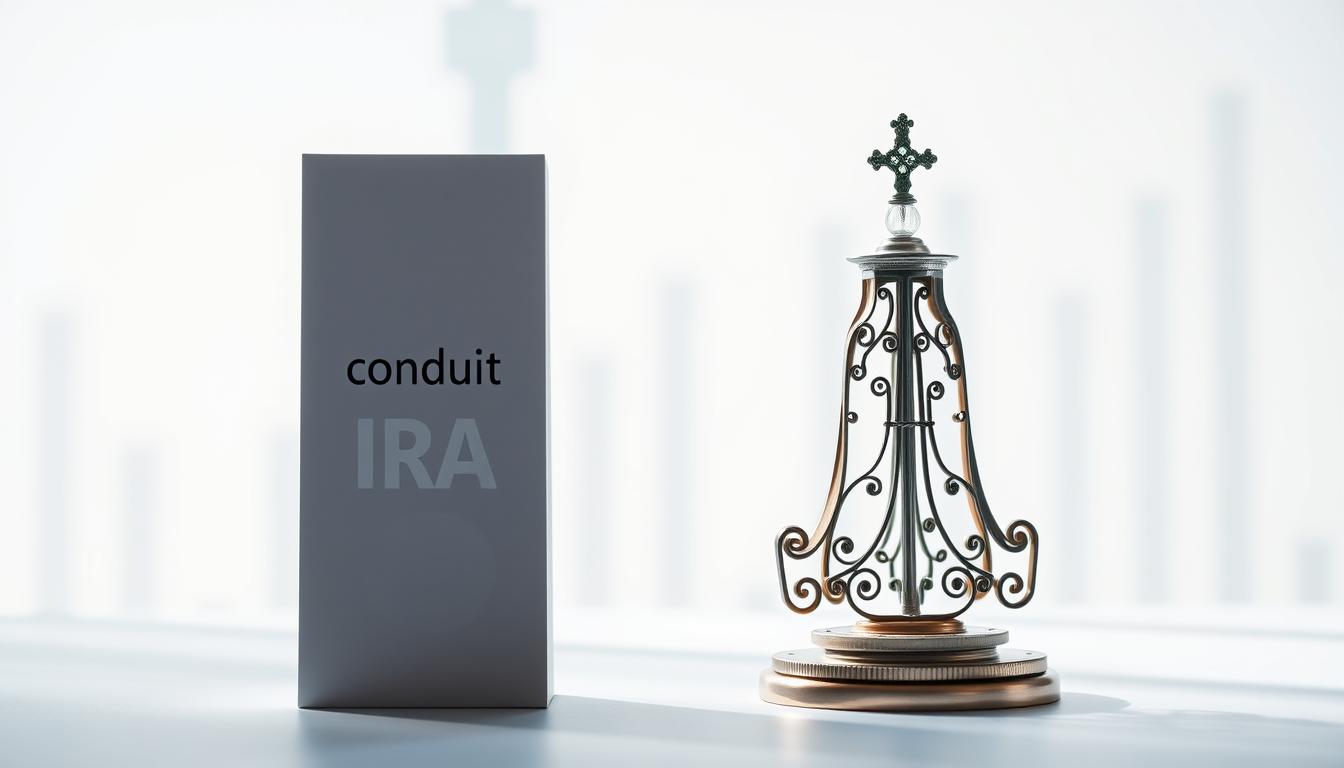A Conduit IRA is a type of Individual Retirement Account that plays a crucial role in retirement planning, especially for those looking to manage their retirement savings efficiently.

It serves as a temporary holding account for funds rolled over from a previous employer’s retirement plan, allowing individuals to later transfer these assets into their current employer’s plan or another IRA without commingling the funds.
This strategy is particularly useful for maintaining the tax-deferred status of the retirement savings and avoiding potential tax penalties associated with early withdrawals.
Key Takeaways
- Conduit IRA is used for rolling over retirement funds.
- It helps maintain tax-deferred status.
- Allows for later transfer into another retirement plan.
- Helps avoid potential tax penalties.
- Essential for efficient retirement planning.
Understanding the Basics of a Conduit IRA
In the realm of retirement planning, the Conduit IRA stands out for its unique characteristics and benefits. A Conduit IRA is designed to help individuals manage their retirement savings more effectively, especially when transitioning between jobs or retirement plans.
To grasp the full potential of a Conduit IRA, it’s essential to understand its definition and key features. The following sections will delve into these aspects, providing clarity on how a Conduit IRA operates under various conduit ira rules.
Definition of a Conduit IRA
A Conduit IRA is a type of Individual Retirement Account that serves as a temporary holding place for retirement funds rolled over from a previous employer’s plan, such as a 401(k) or 403(b). It’s often used when an individual leaves a job and wants to move their retirement savings to a new employer’s plan or an IRA. The primary purpose of a Conduit IRA is to keep these rolled-over funds separate from other IRA contributions, maintaining their qualified status and avoiding potential tax penalties.
“A Conduit IRA is particularly useful for individuals who plan to roll over their retirement funds to a new employer’s plan, as it preserves the tax-deferred status of the original retirement account.”
Key Features of a Conduit IRA
The key features of a Conduit IRA include its ability to accept rollovers from eligible retirement plans, its flexibility in allowing transfers to other qualified plans, and its adherence to specific conduit ira rules that govern its operation.
| Feature | Description |
|---|---|
| Rollovers Allowed | Conduit IRAs can accept rollovers from 401(k), 403(b), and other eligible retirement plans. |
| Transfer Flexibility | Funds can be transferred to a new employer’s plan or another IRA. |
| Tax Implications | Rollovers are generally tax-deferred, but specific rules apply. |
Understanding these features and the governing conduit ira rules is crucial for maximizing the benefits of a Conduit IRA. By leveraging its capabilities, individuals can better manage their retirement savings and make informed decisions about their financial future.
Who Can Benefit from a Conduit IRA?
Understanding who can benefit from a Conduit IRA is crucial for effective retirement planning. A Conduit IRA is designed to help individuals who have received eligible rollover distributions from a qualified retirement plan.
Individuals Eligible for a Conduit IRA
To be eligible for a Conduit IRA, an individual typically must have received a distribution from a qualified retirement plan, such as a 401(k) or 403(b), due to separation from service, disability, or attainment of a certain age. The eligibility criteria are specific, so it’s essential to review the conduit IRA requirements carefully.
Generally, individuals who are eligible include those who have changed jobs, retired, or become disabled. The Conduit IRA allows them to roll over their retirement savings into an IRA, maintaining the tax-deferred status of their savings.
Potential Advantages for Specific Groups
Certain groups can particularly benefit from a Conduit IRA. For instance, individuals with significant retirement savings from a previous employer’s plan can consolidate their assets into a single IRA, simplifying their financial management.
Additionally, self-employed individuals or small business owners may find a Conduit IRA advantageous as it allows them to manage their retirement savings more effectively. The flexibility in investment options available within a Conduit IRA is also a significant benefit.
- Consolidation of retirement assets
- Flexibility in investment choices
- Continued tax-deferred growth
By understanding the benefits and eligibility criteria, individuals can make informed decisions about whether a Conduit IRA is right for their retirement planning needs.
How a Conduit IRA Works
To make the most of a Conduit IRA, it’s essential to grasp its operational framework. A Conduit IRA is designed to facilitate the transfer of retirement funds, providing a straightforward way to manage your savings.
Contribution and Transfer Rules
The rules governing conduit IRA contributions and transfers are crucial to understanding how to utilize this type of IRA effectively. Contributions to a Conduit IRA can be made under certain conditions, and the funds can be transferred from a qualified retirement plan, such as a 401(k), to the IRA without triggering immediate tax consequences.
It’s important to note that not all retirement plans are eligible for transfer into a Conduit IRA. Typically, funds from a previous employer’s plan can be rolled over into a Conduit IRA if the individual has changed jobs or retired. The process involves contacting the plan administrator and the IRA custodian to initiate the transfer.
Investment Options Available
A Conduit IRA offers a range of investment options, allowing individuals to diversify their retirement portfolios. Common investment choices include stocks, bonds, mutual funds, and exchange-traded funds (ETFs). The specific investment options available depend on the IRA custodian.
When selecting investments for a Conduit IRA, it’s essential to consider the individual’s risk tolerance, investment horizon, and retirement goals. A diversified investment strategy can help mitigate risk and potentially increase returns over the long term.
- Stocks: Represent ownership in companies, offering potential for long-term growth.
- Bonds: Debt securities issued by corporations or governments, providing regular income.
- Mutual Funds: Diversified investment vehicles that pool money from multiple investors.
- ETFs: Similar to mutual funds but trade on an exchange like stocks, offering flexibility.
By understanding the rules and options available, individuals can effectively manage their Conduit IRA, making informed decisions to achieve their retirement objectives.
Differences Between Conduit IRA and Traditional IRA
The choice between a Conduit IRA and a Traditional IRA depends on several factors, including structure and tax implications. Understanding these differences is crucial for making informed decisions about your retirement savings.
Key Distinctions in Structure
One of the primary differences between Conduit IRAs and Traditional IRAs lies in their structure. A Conduit IRA is designed to allow individuals to consolidate their retirement savings from various sources into a single account, maintaining the tax-deferred status of those funds. In contrast, a Traditional IRA is a more straightforward retirement savings account that individuals contribute to directly.
Key structural differences include:
- Consolidation capabilities: Conduit IRAs are particularly useful for individuals who have changed jobs or have multiple retirement accounts, as they allow for consolidation.
- Contribution rules: Traditional IRAs have specific contribution limits and rules, whereas Conduit IRAs are more about managing and consolidating existing retirement funds.

Tax Implications Compared
The tax implications of Conduit IRAs and Traditional IRAs also differ significantly. Both types of IRAs offer tax-deferred growth, meaning that the investments grow without being subject to taxes until withdrawal. However, the rules surrounding withdrawals and the tax treatment of those withdrawals can vary.
| Feature | Conduit IRA | Traditional IRA |
|---|---|---|
| Tax Treatment | Tax-deferred; potentially tax-free if rolled over correctly | Tax-deferred; taxed as ordinary income upon withdrawal |
| Withdrawal Rules | Subject to conduit ira withdrawal rules; potentially more flexible | Subject to standard IRA withdrawal rules; penalties for early withdrawal |
Understanding these differences is key to managing your retirement savings effectively. It’s essential to consult with a financial advisor to determine which type of IRA best suits your financial goals and circumstances.
Steps to Set Up a Conduit IRA
Initiating a Conduit IRA is a multi-step process that begins with selecting the right financial institution. A Conduit IRA, by definition, is a type of IRA that allows for the transfer of retirement funds from a previous employer’s plan to an IRA without commingling the funds with other IRA assets, thus preserving the ability to transfer the funds to a new employer’s plan in the future.
Choosing the Right Financial Institution
The first step in setting up a Conduit IRA is to choose a financial institution that meets your needs. Consider factors such as investment options, fees, and customer service. Some institutions specialize in IRA services and may offer more competitive options.
- Look for institutions with a strong reputation and experience in handling IRAs.
- Compare fees associated with managing the IRA, including maintenance and transaction fees.
- Assess the range of investment options available, ensuring they align with your financial goals.
Necessary Documentation and Requirements
Once you’ve selected a financial institution, you’ll need to complete the necessary documentation. This typically includes an application form and may require additional information such as identification and proof of address.
- Complete the application form accurately, ensuring all required information is provided.
- Gather necessary documents, such as identification and proof of address.
- Fund the Conduit IRA by transferring assets from your previous employer’s retirement plan.
After setting up your Conduit IRA, it’s essential to monitor and manage it effectively. This involves regularly reviewing your investment portfolio and making adjustments as needed to ensure it remains aligned with your retirement goals.
Maintaining a Conduit IRA
Maintaining a Conduit IRA requires diligence and a thorough understanding of the rules and regulations that govern it. To ensure that your retirement savings are maximized, it’s essential to stay on top of the management and monitoring of your account.
Regular Monitoring and Management
Regular monitoring of your Conduit IRA is crucial to ensure that your investments are aligned with your retirement goals. This involves reviewing your account statements, tracking the performance of your investments, and making adjustments as needed. It’s also important to be aware of any changes to the conduit IRA rules that may affect your account.

Withdrawal Rules and Regulations
Understanding the withdrawal rules and regulations of a Conduit IRA is vital to avoid any potential penalties or tax implications. Generally, withdrawals from a Conduit IRA are subject to ordinary income tax, and there may be penalties for early withdrawals. It’s essential to familiarize yourself with the specific requirements for conduit IRA distributions to ensure compliance.
To make informed decisions about your Conduit IRA, it’s recommended that you consult with a financial advisor or tax professional who is knowledgeable about conduit IRA requirements. They can provide personalized guidance tailored to your individual circumstances.
Frequently Asked Questions about Conduit IRAs
As you consider a Conduit IRA for your retirement planning, you may have questions about how it works and its benefits. Let’s address some common concerns and misconceptions to help clarify the process.
Clarifying Common Misconceptions
One common question revolves around conduit IRA contributions. It’s essential to understand that contributions to a Conduit IRA are typically made by transferring funds from a qualified retirement plan, such as a 401(k), rather than making new contributions.
Additional Resources for Your Retirement Planning
For more information on managing your Conduit IRA, including understanding conduit IRA withdrawal rules, you can consult with a financial advisor or visit reputable financial websites. These resources can provide you with the guidance needed to make informed decisions about your retirement savings.

A writer, editor, and publisher with a knack for crafting informative articles.

